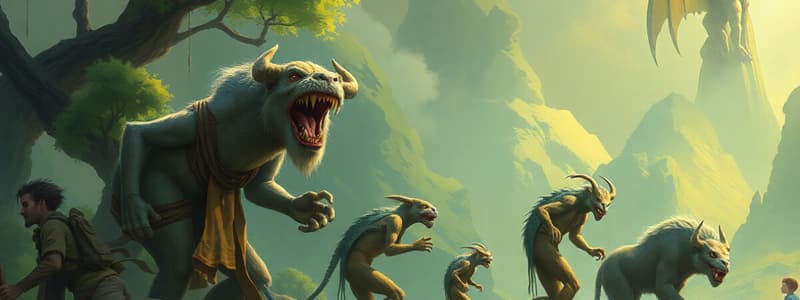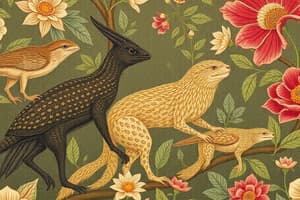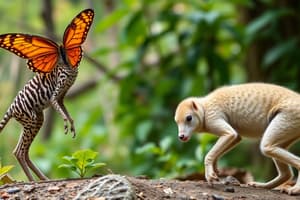Podcast
Questions and Answers
What is the primary mechanism driving the process of adaptation within a population?
What is the primary mechanism driving the process of adaptation within a population?
- Random genetic drift causing chance variations.
- Natural selection favoring advantageous traits. (correct)
- Mutation creating new traits on demand.
- Artificial selection by human intervention.
Which statement accurately summarizes a core tenet of Darwin's theory of natural selection?
Which statement accurately summarizes a core tenet of Darwin's theory of natural selection?
- All individuals in a population are equally likely to survive and reproduce.
- Individuals with advantageous traits are more likely to reproduce and pass on these traits. (correct)
- The environment supports unlimited population growth, eliminating competition.
- Evolution occurs rapidly and predictably in all populations, regardless of environmental conditions.
The concept of 'overproduction' in natural selection refers to what phenomenon?
The concept of 'overproduction' in natural selection refers to what phenomenon?
- A population's capacity to produce more offspring than the environment can sustain. (correct)
- Organisms intentionally producing more offspring than needed.
- Increased mutation rates in offspring due to environmental stressors.
- The ability of a species to rapidly increase its population size regardless of resource availability.
How does 'selection pressure' influence the process of natural selection?
How does 'selection pressure' influence the process of natural selection?
In the example of peppered moths, what was the primary selection pressure that led to a shift in the moth population's coloration?
In the example of peppered moths, what was the primary selection pressure that led to a shift in the moth population's coloration?
What role do genes play in the inheritance of adaptive features?
What role do genes play in the inheritance of adaptive features?
Which of the following scenarios best illustrates natural selection?
Which of the following scenarios best illustrates natural selection?
What is the relationship between evolution and natural selection?
What is the relationship between evolution and natural selection?
How might a population of insects evolve resistance to a newly introduced insecticide?
How might a population of insects evolve resistance to a newly introduced insecticide?
Which of the following is an example of an adaptive feature that helps an organism survive in its environment?
Which of the following is an example of an adaptive feature that helps an organism survive in its environment?
Considering Darwin's theory, what would most likely happen to a species if its environment suddenly changed and its current traits were no longer advantageous?
Considering Darwin's theory, what would most likely happen to a species if its environment suddenly changed and its current traits were no longer advantageous?
What is the significance of studying the peppered moth in understanding natural selection?
What is the significance of studying the peppered moth in understanding natural selection?
How does the concept of 'fitness' relate to natural selection?
How does the concept of 'fitness' relate to natural selection?
Industrial melanism, as seen in the peppered moth, primarily demonstrates which key aspect of natural selection?
Industrial melanism, as seen in the peppered moth, primarily demonstrates which key aspect of natural selection?
Imagine a population of birds where beak size varies. If the only available food source becomes small seeds, what is the most likely outcome over time, assuming natural selection is at play?
Imagine a population of birds where beak size varies. If the only available food source becomes small seeds, what is the most likely outcome over time, assuming natural selection is at play?
Flashcards
Evolution
Evolution
Changes in adaptive features of populations over time.
Natural Selection
Natural Selection
Individuals better suited to their environment survive and reproduce more than less fit individuals.
Adaptation
Adaptation
A process by which populations become better suited to their environment over generations.
Natural Variation
Natural Variation
Signup and view all the flashcards
Overproduction
Overproduction
Signup and view all the flashcards
Struggle for Survival
Struggle for Survival
Signup and view all the flashcards
Survival Advantage
Survival Advantage
Signup and view all the flashcards
Selection Pressure
Selection Pressure
Signup and view all the flashcards
Adaptive Feature
Adaptive Feature
Signup and view all the flashcards
Fitness
Fitness
Signup and view all the flashcards
Phenotype
Phenotype
Signup and view all the flashcards
Peppered Moth (Pre-Industrial)
Peppered Moth (Pre-Industrial)
Signup and view all the flashcards
Peppered Moth (Industrial)
Peppered Moth (Industrial)
Signup and view all the flashcards
Peppered Moth Example
Peppered Moth Example
Signup and view all the flashcards
Genes
Genes
Signup and view all the flashcards
Study Notes
The Theory of Natural Selection
- Evolution refers to the change in adaptive features of populations over time.
- Natural selection is a key process driving evolution.
- Natural selection is the process where individuals better suited to their environment are more likely to survive and reproduce.
- Adaptation results from natural selection.
- Adaptation is the process by which populations become more suited to their environment over generations.
- Charles Darwin explained evolution by natural selection in "On the Origin of Species," published in 1859.
- Variations exist naturally among individuals in a population; some traits make individuals more or less fit for their environment.
- Overproduction occurs when a population produces more offspring than the environment can support.
- Overproduction leads to competition among organisms for limited resources.
- Individuals with traits that make them well-adapted have a survival advantage.
- Well-adapted organisms are more likely to survive and reproduce, passing adaptive features to offspring.
- Less adapted individuals are less likely to survive and more likely to disappear from the population.
- Evolution results in traits that make individuals more suited to their environment becoming more common.
- Traits with little survival advantage become less common or disappear.
- This process can lead to the emergence of new species.
- Darwin stated that natural environmental factors may select for or against specific traits, which is called natural selection.
- As environmental conditions change, different traits may be selected for or against, causing species to change and evolve.
- The inherited adaptive features are encoded by genes.
- Alleles for advantageous phenotypes are passed more frequently from parents to offspring compared to alleles for less advantageous phenotypes.
Peppered Moth Example of Natural Selection
- The peppered moth (Biston betularia) exemplifies natural selection.
- Before the industrial revolution in Great Britain, light-colored speckled peppered moths were more common than dark-colored ones.
- Light-colored moths blended in with lichens on tree trunks, avoiding bird predators.
- Dark-colored moths were easily spotted and predated upon in this environment.
- Bird predation acted as a selection pressure.
- Selection pressure is an environmental factor affecting trait selection, improving an organism's survival.
- Speckled wings provided a survival advantage.
- After the industrial revolution in the 19th century, dark-colored moths became more numerous in industrial areas.
- Local industry released soot, which killed tree trunk lichens and darkened the trunks.
- Dark-colored moths blended with the polluted tree trunks, avoiding predation.
- Selection pressure caused dark-colored moths to have a survival advantage.
- Dark-colored moths lived longer, produced more offspring, and eventually outnumbered speckled moths.
- Alleles for dark-colored wings were passed more frequently, producing a more advantageous phenotype.
Studying That Suits You
Use AI to generate personalized quizzes and flashcards to suit your learning preferences.
Description
Explore the theory of natural selection as a key driver of evolution. Learn how adaptation arises through this process, where better-suited individuals are more likely to thrive and reproduce. Understand Darwin's contribution and the importance of variation and competition.




